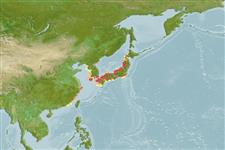Common names from other countries
Issue
Acanthogobius stigmothonus (Richardson, 1845) is considered as valid (from the South China Sea and Gulf of Tonkin) in Shibukawa & Iwata, 2013 (Ref. 93271).
Environment: milieu / climate zone / depth range / distribution range
Ökologie
seewasser; süßwasser; brackwasser demersal; amphidrom (Ref. 51243); tiefenbereich 1 - 6 m (Ref. 96339). Temperate; 52°N - 23°N, 116°E - 143°E
Northwest Pacific: Russian Far East (from Amur to Peter the Great Gulf), Korean Peninsula, Bohai Sea, Yellow Sea and East China Sea of China, and Hokkaido to Kyushu of Japan.
Length at first maturity / Size / Gewicht / Alter
Maturity: Lm 27.0 range ? - ? cm
Max length : 30.0 cm TL Männchen/unbestimmt; (Ref. 2850); common length : 14.5 cm TL Männchen/unbestimmt; (Ref. 12193)
Inhabits muddy and sandy bottoms along the shore of bays and estuaries, sometimes ascends rivers. Intertidal to at least 6.5 m (Ref. 96339). Oviparous, spawn in winter to early spring (Ref. 205). Eggs are deposited in Y-shaped nests (Ref. 205). Used in Chinese medicine (Ref. 12166).
Eggs are deposited near the base of the Y-shaped nest (Ref. 51058).
Shibukawa, K. and A. Iwata, 2013. Review of the East Asian gobiid genus Chaeturichthhys (Teleostei: Perciformes: Gobioidei), with description of a new species. Bull. Nat. Mus. Nat. Sci. Ser. A., Suppl. 7:53-66. (Ref. 93271)
IUCN Rote Liste Status (Ref. 130435)
CITES (Ref. 128078)
Not Evaluated
Bedrohung für Menschen
Harmless
Nutzung durch Menschen
Fischereien: kommerziell; Aquarium: Öffentliche Aquarien
Tools
Zusatzinformationen
Download XML
Internet Quellen
Estimates based on models
Preferred temperature (Ref.
115969): 12 - 21.6, mean 17.9 (based on 189 cells).
Phylogenetic diversity index (Ref.
82804): PD
50 = 0.5156 [Uniqueness, from 0.5 = low to 2.0 = high].
Bayesian length-weight: a=0.00692 (0.00373 - 0.01284), b=3.01 (2.85 - 3.17), in cm Total Length, based on LWR estimates for this species & (Sub)family-body (Ref.
93245).
Trophic level (Ref.
69278): 3.4 ±0.3 se; based on diet studies.
Widerstandsfähigkeit (Ref.
120179): mittel, Verdopplung der Population dauert 1,4 - 4,4 Jahre. (Preliminary K or Fecundity.).
Fishing Vulnerability (Ref.
59153): Low to moderate vulnerability (33 of 100).
